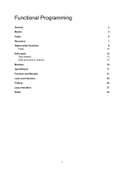Summary
Summary Functional Programming (INFOFP)
- Course
- Institution
- Book
All subjects that are discussed in the Functional Programming course, clearly summarized in a structured way. Based on the lectures and the book Programming in Haskell.
[Show more]




